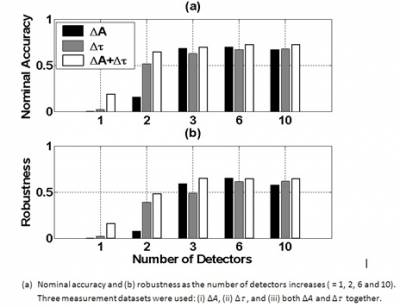Absorption and scattering coefficient dependence of laser-Doppler flowmetry models for large tissue volumes
Based on quasi-elastic scattering theory (and random walk on a lattice approach), a model of laser-Doppler flowmetry (LDF) has been derived which can be applied to measurements in large tissue volumes (e.g. when the interoptode distance is >30 mm) [1]. The model holds for a semi-infinite medium and takes into account the transport-corrected scattering coefficient and the absorption coefficient of the tissue, and the scattering coefficient of the red blood cells. The model holds for anisotropic scattering and for multiple scattering of the photons by the moving scatterers of finite size. In particular, it has also been possible to take into account the simultaneous presence of both Brownian and pure translational movements. An analytical and simplified version of the model has also been derived and its validity investigated, for the case of measurements in human skeletal muscle tissue. It is shown that at large optode spacing it is possible to use the simplified model, taking into account only a ‘mean’ light pathlength, to predict the blood flow related parameters. It is also demonstrated that the ‘classical’ blood volume parameter, derived from LDF instruments, may not represent the actual blood volume variations when the investigated tissue volume is large. The simplified model does not need knowledge of the tissue optical parameters and thus should allow the development of very simple and cost-effective LDF hardware.
Optimising cerebral oxy- and deoxy-haemoglobin concentration changes in a layered adult head model
The non-invasive measurement of cerebral oxy- (∆HbO2) and deoxyhaemoglobin (∆HHb) changes using near-infrared spectroscopy instruments is often affected by the absorption in the extracerebral layer. We have exploited the multivariate calibration (partial least squares, PLS) method to minimize the errors for a range of blood volume, oxygen saturation and extracerebral layer thicknesses [2]. The changes in the mean time of flight of photons (∆τ) and attenuation (∆A) on the surface of a 3D adult head model were simulated using a finite-element method based on the diffusion equation. The PLS was then performed to identify the optimal number of detectors, their positions and weightings, to optimize the estimation of ∆HbO2 and ∆HHb. We define the ‘nominal accuracy’ as the accuracy of estimating ∆HbO2 and ∆HHb over a nominal range of extracerebral layer thicknesses and ‘robustness’ as the accuracy beyond the nominal range. The results showed that for one or two detectors, ∆τ performed better than ∆A while using them together gave the best performance. When more detectors were used, the performances of using ∆τ, ∆A or both together became comparable, showing that a larger number of detectors can compensate for the performance of a simple ∆A measurement despite this measurement having a relatively lower sensitivity to intracerebral absorption changes.

References
- Binzoni T., Leung T.S., Rufenacht D., Delpy D.T., "Absorption and scattering coefficient dependence of laser Doppler flowmetry models for large tissue volumes." Physics in Medicine and Biology (2006) 51:311-333 [URL]
- Leung T.S., Elwell C.E., and Delpy D.T., "Estimation of cerebral oxy- and deoxy-haemoglobin concentration changes in a layered adult head model using near-infrared spectroscopy and multivariate statistical analysis." Physics in Medicine and Biology (2005) 50:5783-5798 [URL]
 Close
Close

